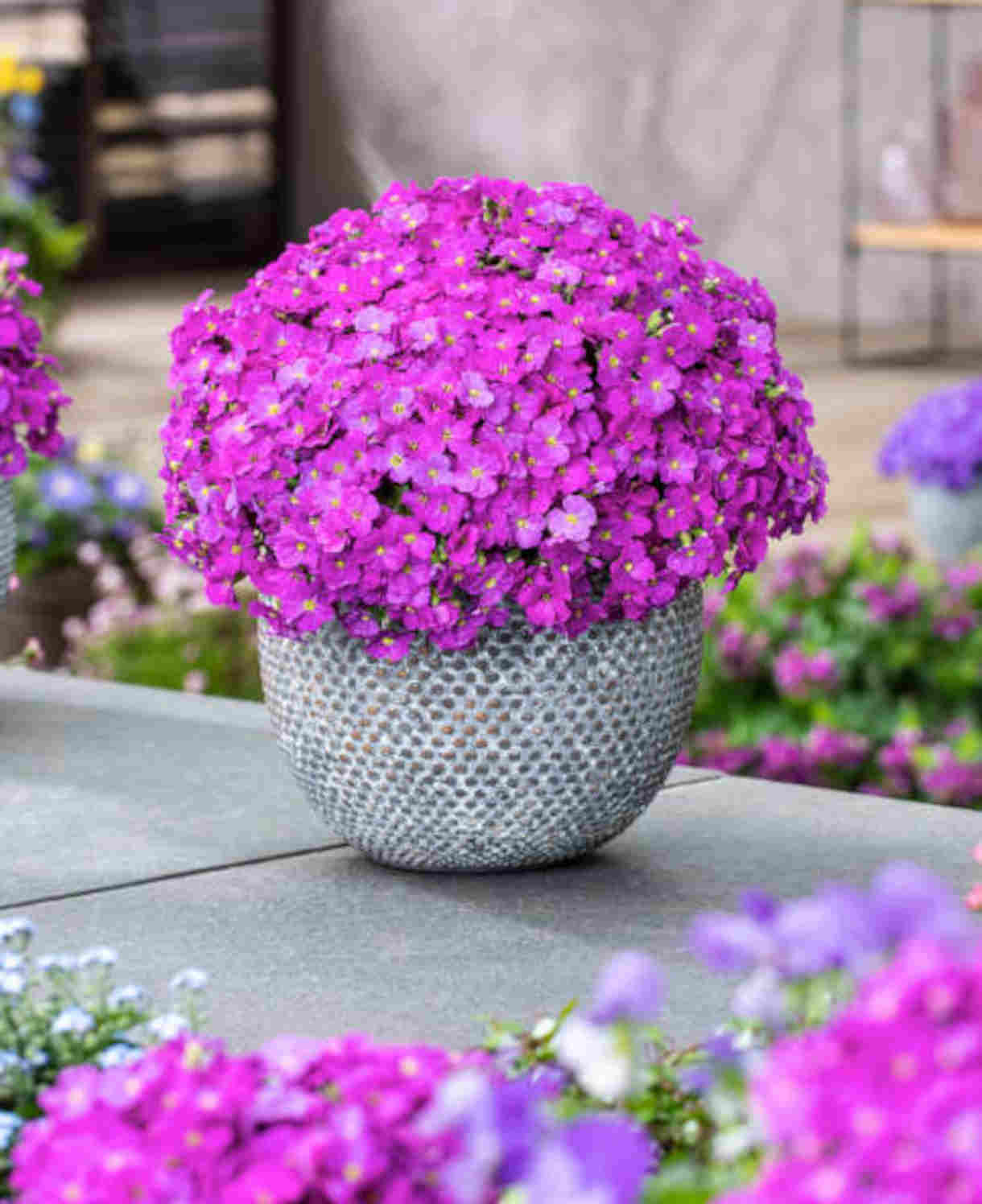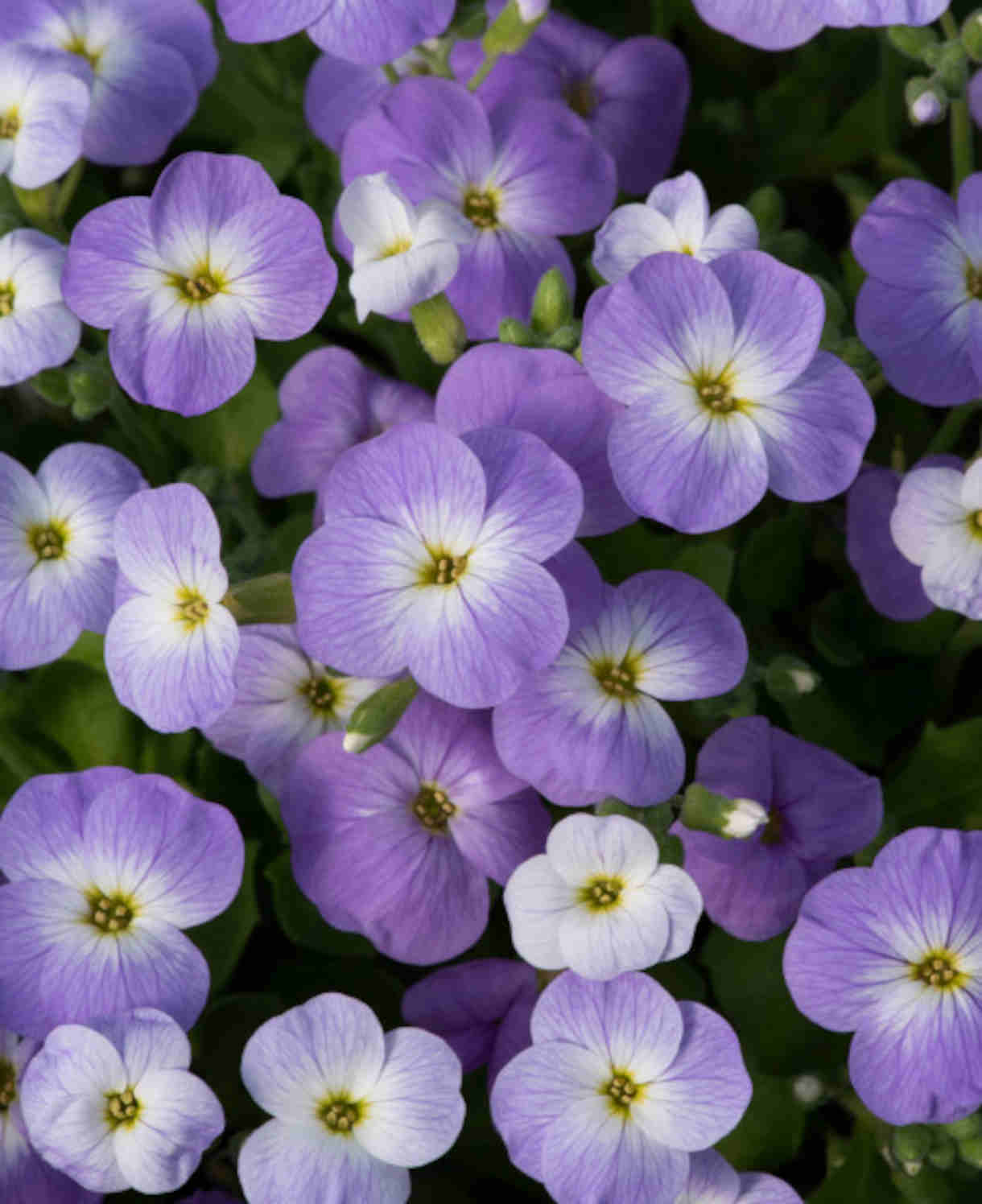How to grow Aubrieta
One of the most popular of all rock plants, aubrietia is an evergreen, carpet-forming perennial which can be seen erupting in brilliant shades of purple, blue and pink throughout March and April. It is a genus of 12 species found throughout Europe and South Asia, though the most spectacular display for gardeners is provided by the many cultivated forms developed over the years.
Aubretia is a member of the brassica family with small, hairy, slightly succulent-looking leaves. In just 2 to 3 years, it will grow into a wide, ground-hugging mat.

Key Information
Position
Soil Conditions
Hardiness


Where & when to plant Aubrieta
Our aubrieta plants are available from early spring when they can be planted straight out into the garden, although if supplied as young plants, please follow the instructions included within your parcel.
Choose a sunny, elevated spot from which your aubrieta can cascade. Try having it tumbling over the edge of a wall, spreading over a rock garden, creeping down a sloping bank, or spilling down the sides of a container. Make sure you give it well-draining soil or compost; aubrieta does not like to sit too damp.
How to plant Aubrieta
In the ground
- Clear the chosen area of weeds.
- Dig a planting hole several times larger than the root ball. If you are gardening on soil that is poor, dry, or stony it is a good idea to mix in some well-rotted organic matter at this stage. Avoid heavy, clay soil if possible.
- Place the plant in the hole, ensuring the top of the root ball sits level with the surface of the soil. Too low and the plant may rot, too high and the roots can dry out.
- Backfill with soil and firm in gently.
- Soak well with water.
- A mulch around the base with horticultural grit will prevent flowers being splashed with mud.
In a container
- Choose an appropriate container. We recommend a pot with a top diameter of approximately 30-35cm. Ensure there are plenty of drainage holes in the bottom.
- Use a good quality potting compost with plenty of horticultural grit mixed in, and, if not already present in the compost (check the description on the bag) some slow-release fertiliser granules.
- Start by partially filling the pot with compost; enough so that when placed on it the upper surface of the root ball is about 3cm lower than the top of the pot.
- Infill all the space surrounding the root ball with compost, firming down with your fingers then adding a little more so the plant is held tight.
- Pick up the pot (if you can!) and lightly tap on the potting bench or ground a few times to help further settle the compost around the plant.
- Soak well with water.
- A mulch with horticultural grit will look attractive and help to prevent a ‘cap’ or crust forming on the top of the compost (something container plants can suffer due to the artificial nature of their watering). It also prevents the flowers from being splashed with compost during watering.

What to plant with Aubrieta
We recommend combining aubrieta with other spreading rock plants able to match it for vigour (and not become swamped!). Lobularia, is an excellent candidate, as well as iberis and Phlox subulata. Use a mix of different aubrietas to give a multi-coloured effect.



How to care for Aubrieta
Pruning and Deadheading
Cut back aubrieta after flowering (though not into any woody growth) to maintain the tight cushion shape and encourage a second flush of flowers. Try to make sure you do this every year, as otherwise aubrietas can become a little scruffy and bare in the middle.
Watering
Water regularly until established, after which aubrietas tend to look after themselves.
Cold Protection
Aubrieta is hardy to -15°C, meaning it should easily come through the average UK winter with no added protection.
Pests and Diseases
As a member of the brassica family aubrieta can fall prey to the dreaded flea beetle, which is responsible for the riddling of leaves with many tiny holes. This tends not to affect the overall health of plants too much, though it can spoil their appearance. If you are really bothered by this, try exploiting the beetles’ habit of jumping when disturbed by coating a piece of card with insect barrier glue and brushing it over the top of plants. This allows you to trap and dispose of the offending pests, though it does need to be done repeatedly.
How to propagate Aubrieta
While aubrieta can be propagated by seed, these rarely come true from cultivated plants. Better instead is to take cuttings, which can be done in mid to late summer.
- Find non-flowering shoots 5-10cm long and, using your fingers rather than secateurs, pull off with a ‘heel’ (a sliver of the parent stem which remains attached if the shoot is pulled in a gentle, downwards motion).
- Put them in a plastic bag straight away to prevent drying out.
- Fill a container with a compost mix which is at least 50% perlite (or if you prefer, as we do, 100% perlite).
- Trim the end of the cutting to just below a node (point at which leaves grow).
- Remove the lowest leaves and soft tip, leaving 2-4 leaves.
- Insert the cuttings into the compost and water lightly. Several cuttings can be put in the same container if there is enough space to do this without them touching.
- Place in a greenhouse or propagating unit if you have one, or covered with a plastic bag on a windowsill if not (out of direct sunlight).
- Keep the cuttings misted and occasionally watered until they root. You will know this has happened when roots emerge out of the bottom of the container.
- Gently remove rooted cuttings and pot them into individual pots. Overwinter in a cool yet frost-free environment such as an unheated conservatory, greenhouse, or cold frame, before planting out in late spring.
- Does aubrieta come back every year?
Yes, this hardy perennial will last for several years – more if kept regularly trimmed (see Pruning and Deadheading section above). - Is aubrieta poisonous to dogs?
No, aubrieta has no known toxicity to animals or people. - How tall does aubrieta grow?
Aubrieta is a carpet-forming plant which tends to get no taller than 5-10cm. It does, however, have a cascading, spreading habit and can reach 60-90cm ‘down’ or across (depending on the topography of where it is grown).
- Can aubrieta grow in shade?
Aubrieta is at its best in full sun. It is possible to grow it in partial shade, though the results with be somewhat sparse, leggy, and less floriferous. Full shade is a definite no.




